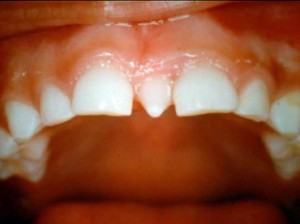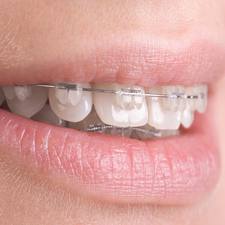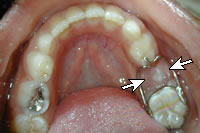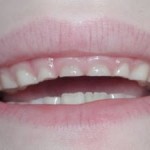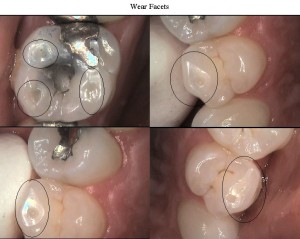Whether or not there is an increase in size or acceleration of growth of the mandible is one of the major controversies in functional appliance therapy. Although many researchers have claimed that the FR causes extra mandibular growth, this study showed that there were no significant differences between the FR and control groups as far as mandibular movement is concerned, the mean FR movement being 4.1 mm, standard deviation 3.0 mm; the control 5.0 mm, and standard deviation 2.6 mm. As the 5.0-mm change in the control was due to normal growth, it can be assumed that the 4.1-mm change in the FR group was no more than normal growth rather than any effect of the appliance. The maximum value seen in the control was 14.2 mm and for the FR it was 12.8 mm; again, because this change in the controls was due to normal growth it must be assumed that even the maximum FR change was no more than normal growth change. That the size of the mandible is unaffected with the FR is supported by evidence from Creekmore and Radney, and Hamilton et al., who found no significant differences between FR and untreated patient groups. Continue reading
Category Archives: Orthodontic
Skeletal and dental changes brought by Frankel appliance Part 1
Functional appliances have been used for many years in the treatment of Class II division 1 malocclusions, the selection of which varies with the type of skeletal and dental anomaly, the growth pattern, and the operator’s preference. Continue reading
Functional appliances
Functional jaw orthpaedics is treatment with functional appliances making use of forces created by the head and neck musculature to bring about the desired dental, facial, and functional changes.
Functional appliances are removable or fixed [cemented] appliances that alter the posture of the mandible [lower jaw] and transmit the forces created by the resulting stretch of the muscles and soft tissues and by the change in the neuromuscular environment to the dental and skeletal tissues to produce movement of the teeth and modification to the growth of the jaws and lower face.
Spacing
Spaced dentition is characterized by interdental spaces and lack of contact points between the teeth. Spacing can be localized or generalized due to the number of teeth included. It is a common esthetic problem for many patients. A study in European adults showed that patients with broad midline spacing were perceived as being less socially successful and having lower intelligence. Continue reading
Crossbite
Crossbite is an occlusal irregularity where a tooth (or teeth) has a more buccal or lingual position (that is, the tooth is either closer to the cheek or to the tongue) than its corresponding antagonist tooth in the upper or lower arcade. Continue reading
Orthodontic Visit
Just like baseball and gymnastics are types of sports, an orthodontist (say: or-thoh-don-tist) is a type of dentist. Using braces, retainers, and other devices, an orthodontist helps straighten a person’s teeth and correct the way the jaws line up.
Straight teeth and aligned jaws create nice smiles. On top of that, when your jaws and teeth are well aligned, it is easier to chew food. Orthodontic care can even help prevent snoring! Continue reading
The Extra Tooth!
Did you ever wonder why do you find some children with a small extra tooth in between their permanent incisors?
This small little tooth is called Supernumerary Tooth.
Â
A Supernumerary Tooth is one that is additional to the normal series and can be found in almost any region of the dental arch. Most supernumerary teeth are located in the upper incisors region commonly known as mesiodens. Their presence may give rise to a variety of clinical problems in the future for children.
Removable orthodontic appliances
Orthodontic treatment can be divided into:
i) Removable orthodontic appliances
ii) Fixed appliances (braces)
iii) Orthognatic surgery
We will be focusing on removable orthodontic appliances in this article.
Firstly, you may want to know what are the types of movement involved in orthodontics and the amount of force required for that movement of a single tooth: Continue reading
Space Maintenance in Children
Â
Â
Space Maintainer is a fixed or removable appliance designed to preserve the space created by the premature loss of a tooth (can be primary or permanent tooth). Fixed Space Maintainer is not intended to be removed by the patient whereas Removable Space Maintainer is designed for easy removal for cleansing and/or adjustment. Continue reading
Top 5 Children Habits You Need to Know About (Part 2)
4. Bruxism
It is a habitual grinding of teeth when the child is not chewing or swallowing. It is divided into Daytime Bruxism (Diurnal) or Night -time Bruxism (Nocturnal). Daytime Bruxism can be conscious or subsconscious grinding along with parafunctional habits and it is usually silent. On the other hand, Night-time Bruxism is categorized as subconscious grinding in a rhythmic pattern. Bruxism happens as a result of faulty fillings, improper teeth occlusion, genetic causes, neurological disturbances, occupational factors, over anxious or stressed children.
Â
What do you notice?
From the tooth surfaces, you will observe your child’s teeth are very much worn off. This feature is called atypical wear facet, whereby the worn area are shiny, uneven with sharp edges on the upper and lower front teeth. Fillings may fracture or tooth may chip off as a result of grinding. Teeth will become mobile and very sensitive to cold and hot food. Besides that, your child may complain of muscular tenderness and fatigue around the cheek on rising in the morning. Jaw movements restricted and difficult in opening mouth for a long time.
   Â

